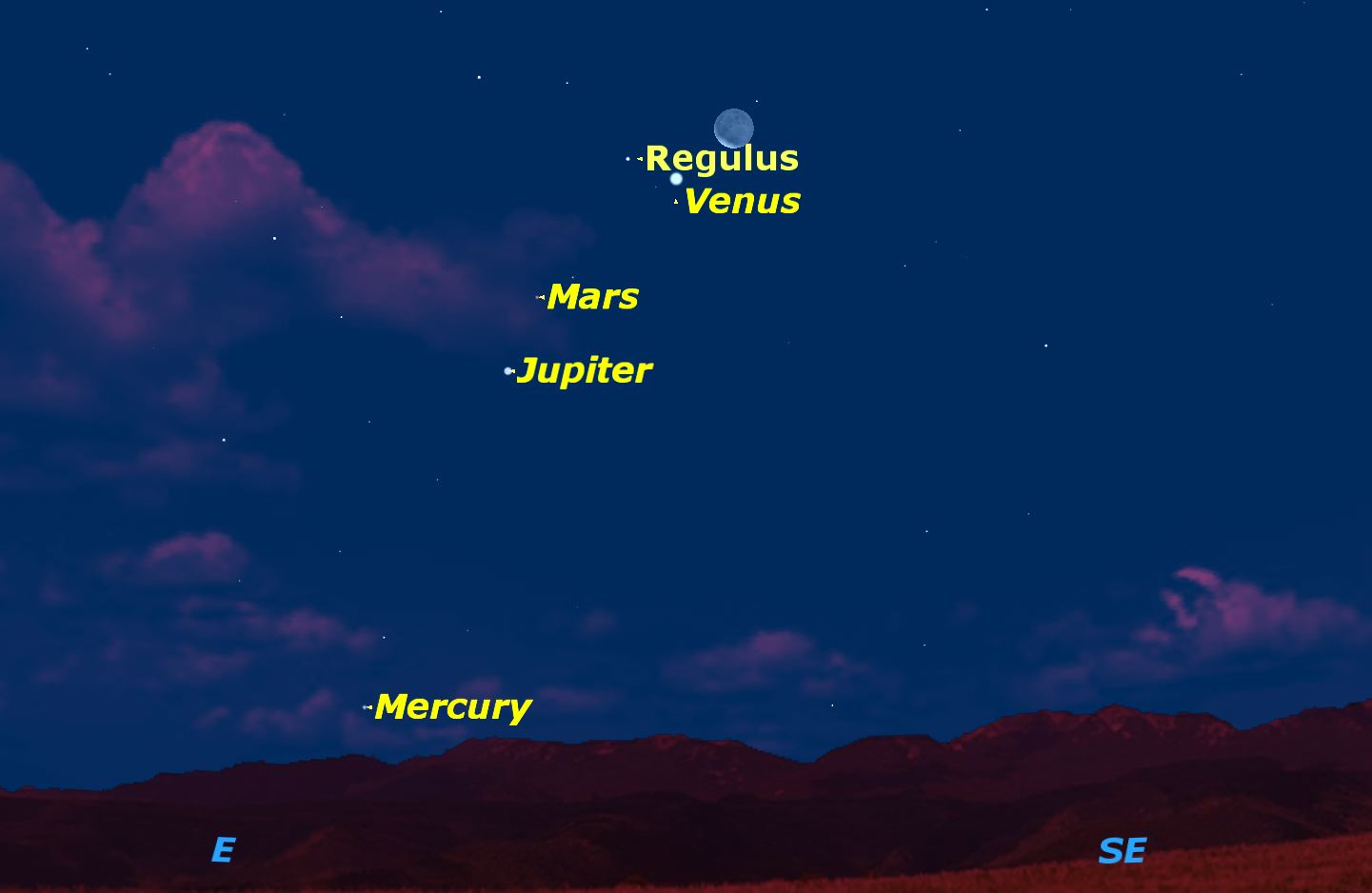The Moon Goes Visiting: Bright Views in This Week's Early Morning Sky

If you’re delighted by the ever-changing sky, here are some of its brightest inhabitants to watch for this week just before dawn.
Just before dawn, you'll be able to view four bright planets. And now that October is here, and the days are getting shorter for those of us in the northern hemisphere, the sun rises around 7 a.m., so you don't have to get up particularly early to check out the predawn view.
Venus, as usual, is the brightest of the bunch, with Jupiter close behind. Mars and Mercury are more challenging, and you may need binoculars to spot them. Watch them over the next few weeks, and you'll see a changing pattern of bright objects. [10 Must-See Stargazing Events to Look Up for in 2015]
Venus and Mercury are tethered close to the sun, but the other planets and stars will be marching westward night by night.
This week, the waning crescent moon will be moving through the four planets toward the horizon, heading to new moon on Oct. 12.
The Moon
Thursday morning, Oct. 8, the moon will be close to Venus. In fact, the moon will even pass in front of Venus for observers in Australia, New Zealand and Melanesia.
Friday morning, Oct. 9, the moon will be in a close grouping with Mars and Jupiter.
Breaking space news, the latest updates on rocket launches, skywatching events and more!
Saturday morning, Oct. 10, the moon will be about halfway between Jupiter and Mercury, and will be a useful guide for spotting Mercury.
Finally, on Sunday morning, Oct. 11, for those of you with low eastern horizons, a thumbnail of a moon will be very close to Mercury, even passing in front of it in southern South America. Look for Mercury just above and to the left of the moon.
Parallax effect
A good way to see the effects of parallax, an object's movement against a more distant background, is during a close passage of the moon in front of four planets. Depending on where you live on Earth, north or south, you will see the moon as nearer or farther away from individual planets. At present, Venus is the only planet south of the ecliptic — the sun's path through the stars — so it is the most likely planet to get covered by the moon, which is also south of the ecliptic.
Another thing to look for this week is the earthshine or earthlight, from sunlight reflected onto the moon's "dark" side by the Earth. A close look will show a faintly glowing "full moon" just above the sunlit crescent.
Early gems
If you get up a little earlier this week, you will get a fine preview of the winter sky. Look for the constellation of Orion close to the meridian, and the bright star Capella directly overhead. No fewer than eight first-magnitude stars are visible in the nighttime sky. This is a wonderful chance to observe the gems of the winter sky when the temperature is a lot warmer than it will be in January, when these same objects will appear in the evening sky.
Editor's note: If you capture an amazing image of the night sky that you would like to share with Space.com and its news partners for a story or photo gallery, send photos and comments in to: spacephotos@space.com.
This article was provided to Space.com by Simulation Curriculum, the leader in space science curriculum solutions and the makers of Starry Night and SkySafari. Follow Starry Night on Twitter @StarryNightEdu. Follow us @Spacedotcom, Facebook and Google+. Original article on Space.com.

Geoff Gaherty was Space.com's Night Sky columnist and in partnership with Starry Night software and a dedicated amateur astronomer who sought to share the wonders of the night sky with the world. Based in Canada, Geoff studied mathematics and physics at McGill University and earned a Ph.D. in anthropology from the University of Toronto, all while pursuing a passion for the night sky and serving as an astronomy communicator. He credited a partial solar eclipse observed in 1946 (at age 5) and his 1957 sighting of the Comet Arend-Roland as a teenager for sparking his interest in amateur astronomy. In 2008, Geoff won the Chant Medal from the Royal Astronomical Society of Canada, an award given to a Canadian amateur astronomer in recognition of their lifetime achievements. Sadly, Geoff passed away July 7, 2016 due to complications from a kidney transplant, but his legacy continues at Starry Night.

